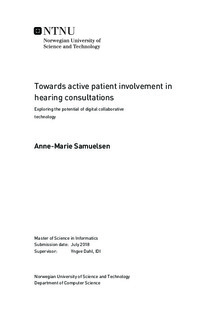Towards active patient involvement in hearing consultations - Exploring the potential of digital collaborative technology
Master thesis
Permanent lenke
http://hdl.handle.net/11250/2564785Utgivelsesdato
2018Metadata
Vis full innførselSamlinger
Sammendrag
This thesis has investigated hearing consultations with the intention of informing design of technology that can support active patient involvement in such encounters and improve patient-practitioner collaboration.Patient-centered care is an essential concept regarding interactions between patient and practitioner. It is through these interactions that patients and practitioners can reach a common understanding of a patients hearing problem and how they can be treated. Hearing consultations typically take place face-to-face in collocated settings. This is observed to have several advantages through the qualitative methods employed as part of my investigation.
The field observations particularly showed how empathic relations, the audiologist's ability to "package" or convey medical information in a manner that would be understandable for the individual patient, is a key quality. The use of tacit knowledge is also a skill that the audiologist uses to know what questions should be asked to the patient in order to steer the consultation in the right direction. Nevertheless, challenges exist, such as the ability of patients to describe their hearing problem and how the consultation environment creates a communication barrier. The focus group concluded that the audiologist cannot be replaced by technology, as audiologists acquire the ability to tailor information to the patients need, and give the patients the necessary compassion and emotional support. Findings from both field observations and focus group illustrates in many ways how face-to-face interaction enhances the quality of the communication in a hearing consultation, but at the same time opens up for challenges.
